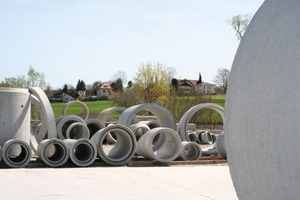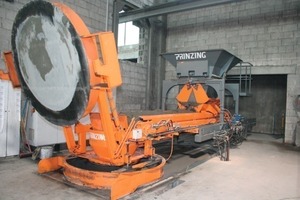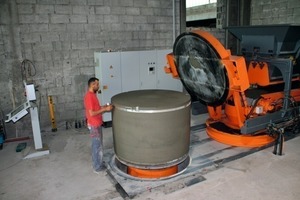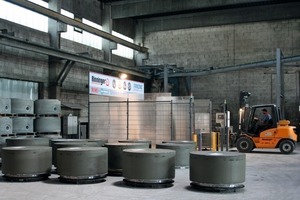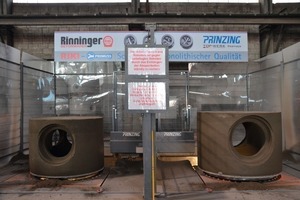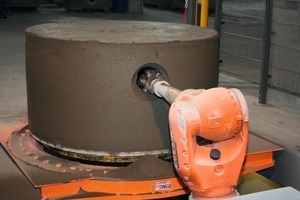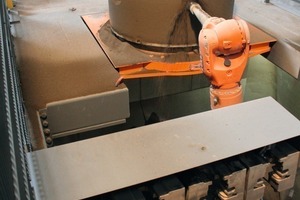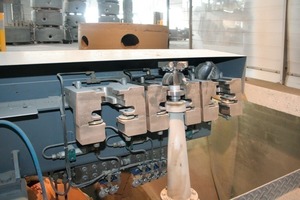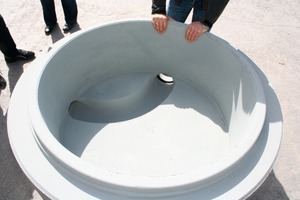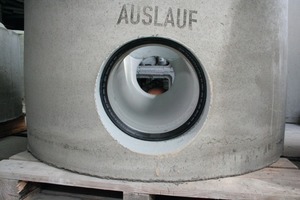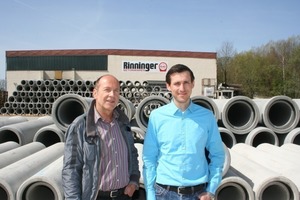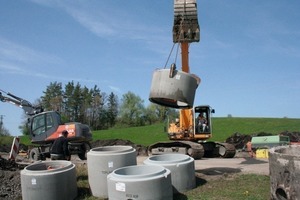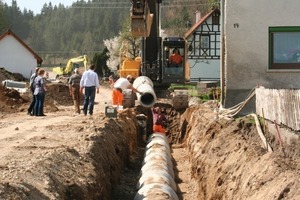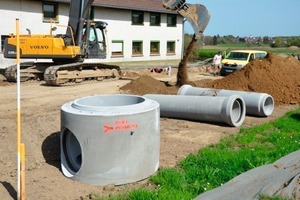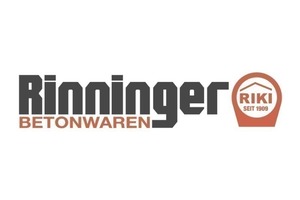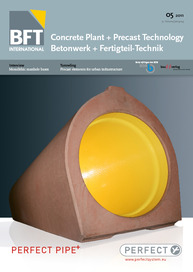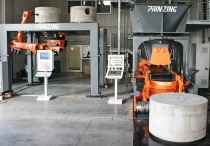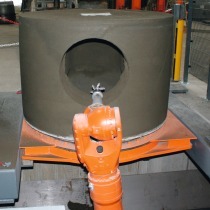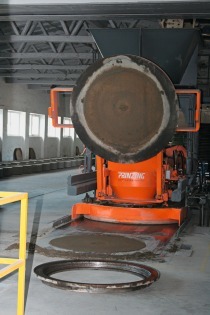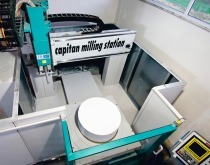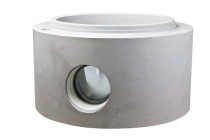A speedy little robot works in the Allgäu region
Since 1909, Rinninger, a family-run company in the South German Allgäu region, has been manufacturing concrete products. Today, the fourth generation of the family is dedicated to producing concrete and precast components. BFT editorial staff met managing director Jörg Rinninger at the factory to visit the newly installed Primuss® line for monolithic manhole bases in operation.
At Kißlegg in Baden-Württemberg, the company offers a product portfolio that is rather unusual in today‘s market environment because the range encompasses almost everything from concrete pavers to pipe systems and structural precast. In civil engineering, Rinninger even supplies the entire range of products. Reinforced concrete pipes in diameters from DN 300 to DN 3000 and manhole units up to DN 3000 in size are manufactured as complete systems and shipped to customers. The range also includes box culverts, slot drains and sedimentation structures. In the building construction segment, Rinninger produces double walls, filigree floors, columns, floor slabs, balconies and other elements - virtually everything except prestressed concrete. For gardening and landscaping, the company manufactures the complete range of concrete products and precast elements used for outdoor facilities. A ready-mixed concrete plant serving local construction contractors rounds off the scope of products and services offered. Even though the current range does appear comprehensive, managing director Jörg Rinninger stresses: „We are constantly adding new products because our range is not set in stone. We either derive innovations from our processes or respond to market demand. Both aspects are part of our company philosophy. For instance, we have been producing our RIKI big block for quite some time, which makes it possible to re-use our residual concrete.“
Aiming for monolithic manhole bases
Some time ago, the fourth Rinninger generation had no difficulty in quickly and clearly defining the objective: manually produced manhole bases were considered a thing of the past, monolithic bases should dominate civil engineering in the future. In Kißlegg, too, manhole bases had still been produced manually, which is why the business was looking for a manufacturing technology capable of meeting the newly defined requirements. For reasons of cost efficiency, the company quickly favored the Primuss process offered by Prinzing. Other available production methods using styrofoam were ruled out because of the additional work steps needed, the inevitable styrofoam waste and the required footprint.
In February 2010, shortly before the bauma, Rinninger purchased the production line from Prinzing, the engineering company. It took the business only little time to decide in favor of this option, and the plant was commissioned equally quickly. In August 2009, Rinninger began producing the first new manhole bases. Staff at Rinninger are enthusiastic about the Primuss solution. Jörg Rinninger comments: „We do know that any decision taken by a precast plant in favor of a process for producing monolithic manhole bases is always linked to the company philosophy. Ultimately, however, you select the most economical solution from a business point of view whilst at the same time trying to predict the future and pertinent technologies as far as reasonably possible. Today, any competitive edge you can get is crucial for surviving in the market.“ With the benefit of hindsight, Rinninger is now in a position to say that the decision to include pipe liners in codes and standards was wrong. The new Primuss process demonstrates that things can be handled differently. Among other features, this concept relies on a uniform sealing system using a wedge-shaped slide seal. Right from the outset, sealing joints are designed in such a way that the pipe can be flexibly integrated in the manhole base. This uniform sealing approach is also beneficial to the company‘s customers.
The Primuss line at Kißlegg is the third of ten systems currently installed in Europe. This shows, that a good acceptance on European market was reached in short time.
One of the details that had to be clarified when installing the Primuss line was its integration with the existing order entry system. Rinninger uses the Gesys software, which is quite popular with operators of precast plants. Thus both programs were to be merged, which was achieved very easily and without any adverse effect on the existing workflow at the Rinninger factory. Customers send their orders to the precast plant where all items and their configurations are entered in Gesys. The drawing generated in this process is sent back to the customer for checking its plausibility and approving it. Finally, all order parameters are transmitted to the Primuss computer, which uses the APsolut software to convert the manhole bases to commands controlling the Atlas manhole machine and the milling robot. The control unit automatically calculates the milling commands for the robot on the basis of the order data entered in the system. Richard Kraiß, managing director of Prinzing GmbH and one of the main inventors of the system, recounts: „This is where the actual difficulty of our idea was. We had to come up with a programming solution capable of capturing the information from the channel data, converting it and translating it into milling commands. But this did not prevent us from inventing the most economical process for the production of monolithic manhole bases. This approach got us to a point where we quickly realized that the process should be feasible using low-slump concrete. SCC would not only incur higher materials costs but also require a more sophisticated mold logistics system. The good thing was that we collaborated with Kuka, a very experienced partner knowing where to make the right adjustments.“ In the meantime, the Blaubeuren-based supplier Prinzing has recruited own people for adjusting the program configuration to the specific needs of each customer.
Key production parameters include the diameter but also installation height and channel dimensions. Once the customer has approved the drawing and/or the order, the system at the precast plant generates a so-called manufacturing slip with a barcode printed on it. This slip remains linked to the precast item during the entire production process and is even attached to the precast product for labeling purposes at the end of the process.
Primuss manhole bases have become the standard solution for Rinninger. The old, conventional bases are produced exclusively upon prior request. Jörg Rinninger confirms that about 90% of all customers are satisfied with this product shift. According to him, the remaining 10% are specifiers not willing to move beyond old tender wordings and tried and tested old processes.
Manufacture of the monolithic products
The manhole bases are manufactured in a monolithic process on the new Atlas system supplied by Prinzing, which is part of the Primuss concept. The machine receives the low-slump concrete from the mixing unit located in the adjacent factory building. Four mold items for various wall thicknesses are available for producing the bases: DN 1200 (270 and 200 mm thick), DN 1000 (210 and 150 mm). A vibro compaction and pressing process is used for compacting the manhole items. Again, Prinzing implemented new solutions because the only mold item to be exchanged in this production step is the jacket.
Two fine-aggregate concrete grades are available for casting. The standard manhole base called Primuss Basic uses a C 60/75 concrete with a water penetration depth smaller than 10 mm. A C 80/95 concrete is used whenever the manhole and channel specifications are more demanding. Such products are called Primuss Pro and ensure penetration depths smaller than 5 mm. A charcoal gray paint is applied to these manhole bases, which makes them easy to distinguish from the standard items.
The quality of the fine ultra-high performance concrete is controlled by PÜZ Bau, an external quality control service provider. The concrete always receives the required certificates and labels. Also, the entire components are subjected to tests in accordance with the pertinent DIN V 4034-1 standard - and they easily pass them all. Just recently, drill cores replaced the conventional test cubes used to check the concrete properties. This procedure is based on DIN EN 1917, which specifies core extraction. The fact that Rinninger has defined such an ambitious program for its products is due to the company‘s tradition rooted philosophy.
Milling the channels
The finished manhole base is moved to the curing area located between the manhole machine and the milling unit. Once the manhole can be lifted, a concrete strength has been reached that is sufficiently high to start the milling process.
There are some skeptics in the industry who consider it difficult, within this system, to identify the point in time that is most appropriate for milling. Confronted with this question, Richard Kraiß responds: „If the concrete strength is higher already, for instance due to delays in the production process, the milling head automatically modifies the milling process through its power supply.“
The complete process of producing a milled manhole base requires an average net working time of half an hour. Labor cost has also been reduced: 1.5 people suffice to operate the manhole production line.
The milling robot has been installed in a basement underneath the factory floor and controls two work stations. While milling is underway at Station 1, the forklift moves the next manhole base to Station 2. This means that the robot works in an overhead arrangement and uses the spherical cutter to mold the channel from the bottom, which takes less than five minutes on average. Then the robot rapidly moves to the tool magazine, which is located on the rear side of the pit, and automatically shifts to the disc cutter, which is used to create the required pipe connections. The process is fully automated and happens almost completely on its own because all component parameters are stored on the product slip in the control unit. The entire milling process takes less than ten minutes. A traffic lights system installed at the work station signals the specific process status to the operators: „ready; channel in progress; new channel to be delivered; job completed; malfunction“ etc. are clearly visualized by the lights.
The milling unit provides the option of creating pipe connection gradients from 1 to 20%. There is also a great degree of flexibility regarding the channel - almost any gradient can be chosen.
The residual concrete resulting from the milling process is still earth-moist and can thus be fed back into the production process. Two conveyors running transverse to each other ensure that the dropping concrete is collected and transported back to the mixer. It should be noted, however, that the quantities generated per each manhole are rather small.
The milling robot in detail
The installed milling robot was supplied by Kuka. With a availability rate of 99,9 %, this unit made in Germany ensures an extremely low degree of maintenance unrivalled the world over. All robot joints are encapsulated and immersed in an oil bath, which is another feature that makes maintenance easier. Add to this the wide reach of the installed robot that enables a working radius of 3.5 m. The quick advance rate of 600 mm/s results in short milling times for the channel layouts. The milling head consists of polycrystalline diamond (PCD) and works at a speed of 4,200 rpm. To produce a single manhole base, 4,000 to 6,000 commands need to be executed, which is a remarkable figure indeed.
Skeptics doubting the benefits of the Primuss system often refer to the wear of the milling head. According to the manufacturer, however, the associated cost is significantly below 1 euro per manhole component.
Monolithic manhole base
After the hardening process, the seals are glued onto the manhole bases, which provides added safety because no seal may get lost under the harsh site conditions.
For instance, Rinninger has already supplied projects as far away as in Oslo or Athens, where German contractors were involved in the project and insisted on selecting precast products from Kißlegg.
The Kißlegg facility currently produces about 40 manhole bases per day, which are also labeled as „Primuss“ products.
Transport anchors are used exclusively for bulky, heavyweight elements. Hooks are used as an alternative.
Summary
„The way in which we process manhole base production internally has become much more efficient and error-free; it‘s just like on an assembly line,“ enthuses Jörg Rinninger. „In addition, we have achieved maximum flexibility because we are able to supply any manhole base at short notice. We are now in a position to ensure next-day delivery if things get tight on the construction site.“ The amount of cleaning required for machinery and molds has also been reduced dramatically, which contributes to ensuring cost efficiency and economical operation. In the past six months, Rinninger has produced over 3000 manhole bases on the Primuss system already. The only thing that the Rinninger family would still wish for is that a greater share of premium - Primuss Pro - monolithic manhole bases be specified so that their use becomes more widespread in day-to-day business.
In conclusion, the company takes pride in having successfully installed the new production line. The installation period was quite difficult for the business because the room to maneuver was restricted as the Primuss system was set up in the work area normally used for producing the conventional manhole bases in the manual process. Add to this the concrete technology solution, which had to be developed, too. Yet in-house laboratory staff solved this problem in record time. Jörg Rinninger thanks his two concrete technologists: „Concrete is the key. And I‘m glad that my team had the courage and ideas needed to implement the new solution.“
Richard Kraiß adds: „I firmly believe that our system is the best and most economical commercially available system for the production of monolithic manhole bases. And the investment and thus the depreciation over time or in relation to the produced elements are well worth it. At any rate, the Primuss system does pay off - very quickly!“

